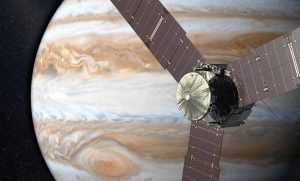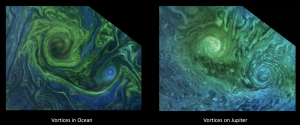
Juno space probe © NASA/JPL-Caltech/SwRI/MSSS
Jupiter’s atmosphere is one of the most turbulent places in the solar system. Lightning and thunderstorm observations point to moist convection as a small-scale energy source for Jupiter’s large-scale vortices and zonal jets. Since 2017, the NASA Juno spacecraft discovered that Jovian high-latitudes host polar vortex crystals, i.e. geometrically organized clusters of large cyclones (diameter of ~ 5,000 km each) associated with intermediate (~ 1,600-500 km) and smaller-scale vortices and filaments (~ 100 km). Research by our group has shown that the turbulent dynamics of Jovian high latitudes is reminiscent of the one present in our own ocean and atmosphere (e.g. in terms of energy transfer, frontogenesis and moist convection). Learning about the dynamics of extra-terrestrial systems helps us better understand our own planet, and conversely.
Research by our group has addressed a wide range of topics relevant to Jovian polar dynamics including:
- Moist convection and energy transfer
- Frontogenesis at Jovian high latitudes
- Formation and persistence of the polar vortex crystal

© NASA press conference AGU 2021
Relevant publications:
- Siegelman, L. and Klein, P. (2024). Frontogenesis at Jovian high latitudes. Nature Physics. https://doi.org/10.1038/s41567-024-02516-x
- Siegelman, L., Klein, P., Ingersoll, A. P., Ewald, S. P., Young, W. R., Bracco, A., Mura, A., Adriani, A., Grassi, D., Plainaki, C., & Sindoni, G. (2022). Moist convection drives an upscale energy transfer at Jovian high latitudes. Nature Physics, 19. https://doi.org/10.1038/s41567-021-01458-y
- Siegelman, L., Young, W. R., & Ingersoll, A. P. (2022). Polar vortex crystals: Emergence and structure. Proceedings of the National Academy of Sciences of the United States of America, 119(17). https://doi.org/10.1073/pnas.2120486119
- Ingersoll, A. P., Ewald, S. P., Tosi, F., Adriani, A., Mura, A., Grassi, D., Plainaki, C., Sindoni, G., Li, C., Siegelman, L., Klein, P., & Young, W. R. (2022). Vorticity and divergence at scales down to 200 km within and around the polar cyclones of Jupiter. Nature Astronomy. https://doi.org/10.1038/s41550-022-01774-0
 North pole of Jupiter © NASA/JPL-Caltech/SwRI/MSSS |
Movie depicting the formation of a polar vortex crystal. |
